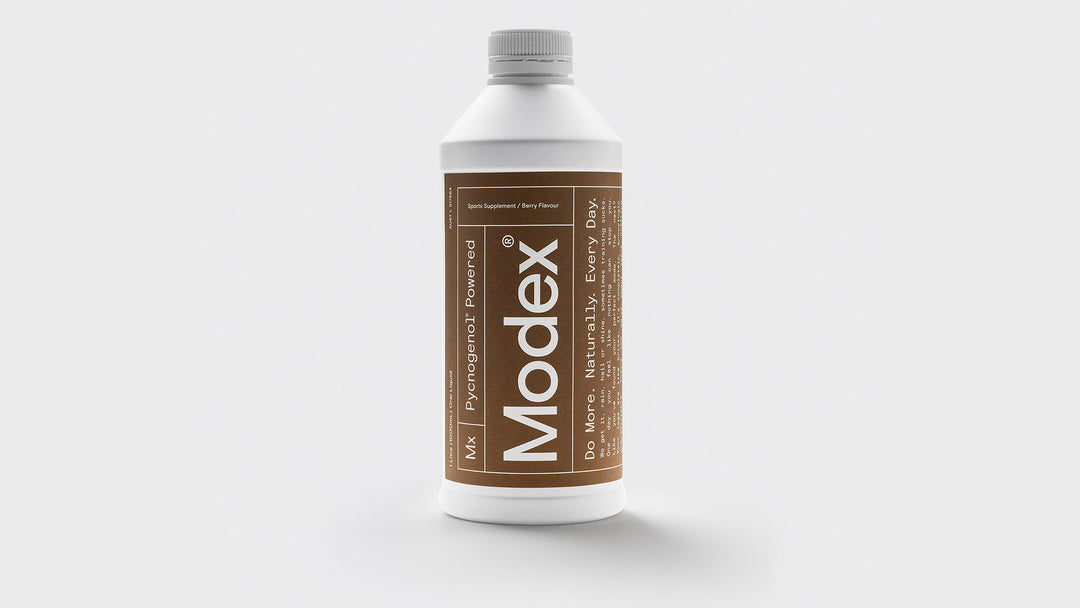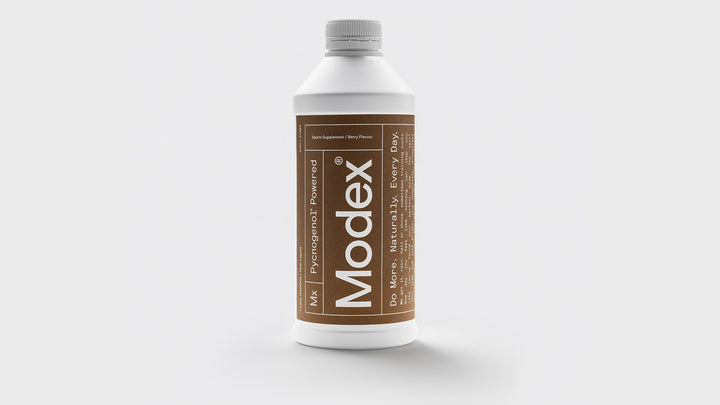Benefits & Scientific Mechanisms of taking Modex
Written by Chris van der Poel (PhD)
Senior Lecturer, Department of Microbiology, Anatomy, Physiology & Pharmacology (MAPP) La Trobe University
We wanted to provide an explanation to triathlon coaches about the benefits and scientific mechanisms for taking Modex to improve performance and recovery in their athletes. i.e. “taking 100ml Modex daily for 2 weeks may improve performance through the following mechanisms”
Three key physiological factors that contribute towards success in triathlon include:
1. V02 MAX

The highest rate of oxygen delivery that can achieved during maximal exercise, known as the VO2max. VO2max is the product of cardiac output (the amount of oxygen than can be delivered the skeletal muscles) and oxygen extraction (the amount of oxygen that can be used by the skeletal
muscles to produce energy).
2. LACTATE THRESHOLD
The size of the lactate threshold (i.e., the exercise intensity an athlete can sustain before a performance limiting rise in metabolic by-products occurs.
3. MOVEMENT ECONOMY/EFFICIENCY

Movement economy/efficiency: How efficient the body is at converting oxygen into useable energy to sustain exercise (known as movement economy or efficiency). In general, any factor that can increase a triathlete’s VO2max, lactate threshold, or decrease the energy cost of movement will enhance their performance. Regular endurance training aims to increases one or all these performance-related factors to enhance endurance performance. During exercise, skeletal muscle blood flow increases almost 100-fold to provide more oxygen to the contracting muscles. Regular endurance training not only increases
oxygen delivery to the skeletal muscle, but also improves oxygen extraction from the blood into the body’s energy powerhouse, the mitochondria. Since the mitochondria are responsible for producing the body’s energy currency, adenosine triphosphate (ATP), a training-related increase in amount and size of the mitochondria in the muscle increases the amount oxygen available to replenish ATP and thus skeletal muscle contraction, in turn improving muscular endurance.
Pycnogenol is a bioactive compound that increases blood flow to working muscles by dilating the blood vessels. Since oxygen transport to the skeletal muscle during exercise is a critical determinant of endurance performance, pycnogenol may enhance your endurance performance.
So how does an increase in blood flow improve endurance exercise performance?
1. INCREASED MUSCLE OXYGEN DELIVERY

Pycnogenol increases the availability of nitric oxide in the blood, a substance that promotes blood vessel dilation resulting in decreased peripheral resistance (resistance to blood flow), meaning more blood can be directed to the skeletal muscles during exercise. Since blood carries oxygen, increasing skeletal muscle blood flow means oxygen can be delivered at a higher rate to the mitochondria
located in the skeletal muscle to support oxygen-dependent (aerobic) energy metabolism (the breakdown of food such as carbohydrates and fats into useable energy). The rate at which skeletal muscle oxygen delivery can be maintained during exercise is an important determinant of the exercise intensity that you can exercise at before becoming fatigued. Hence, increasing nitric oxide availability
in the blood leads to improved blood flow to the skeletal muscle, which in turn improves the skeletal muscle oxygen rate during exercise, meaning triathletes can sustain a higher exercise intensity before reaching fatigue.
2. INCREASED LACTATE THRESHOLD
Lactate threshold is a good marker of endurance exercise performance. The lactate threshold represents the highest exercise intensity that an athlete can exercise at in a metabolic steady state,
i.e., where lactate appearance in the blood and disposal are in equilibrium and without the accumulation of performance-limiting metabolites (e.g., H+, inorganic phosphates, K+, AMP). The higher an athlete’s lactate threshold, the higher the exercise intensity they can sustain before performance-limiting metabolites accumulate. The skeletal muscle is one of the main sites where lactate is converted into the muscle’s energy unit, adenosine triphosphate (ATP) by mitochondria, which is used to fuel skeletal muscle contraction. It stands to reason that increasing blood flow should increase the rate at which lactate is transported to metabolically active tissues, converted into ATP by the mitochondria, and its subsequent removal from the blood plasma. Hence, improving skeletal muscle blood flow after 2 weeks of pycnogenol supplementation may increase an athlete’s lactate threshold.
3. INCREASED EXERCISE EFFICIENCY

Long-term (~4 week) supplementation with Pycnogenol, the active compound in Modex has been shown to increase skeletal muscle metabolic efficiency in sub-elite athletes due to improved skeletal muscle blood flow and contractile efficiency, meaning that less energy is required to perform at the same exercise intensity. Better skeletal muscle metabolic efficiency may improve a triathlete’s ability to tolerate higher exercise intensities for longer.
4. IMPROVED POST-EXERCISE RECOVERY RATE
Beyond the performance improvements, Pycnogenol has shown potential benefits to accelerate post-exercise recovery times due to its potent anti-inflammatory and antioxidant properties. Delayed onset muscle soreness (DOMS) – DOMS is a common post exercise symptom and although there have been many proposed mechanisms to account for DOMS, its exact causes remain unresolved. A major mechanisms influencing onset of DOMS seems to be elevated oxidative stress.
Pycnogenol has been shown to reduce oxidative stress by increasing the amount of anti-oxidative enzymes and by acting as a potent scavenger of free radicals. While the evidence is still emerging, Pycnogenol has been shown to reduce free radicals in the blood after exercise which has been associated with reduced post-run muscular pain, cramps, muscle straining, and localised pain.


























Leave a comment